Smart Grid Technology Review: Microgrids, Nanogrids, and Applications
VerifiedAdded on 2022/10/14
|26
|7534
|312
Report
AI Summary
This report provides a comprehensive review of smart grid technology, with a particular focus on microgrids and nanogrids. The executive summary introduces the topic, highlighting the significance of smart grids, which incorporate technologies like microgrids and nanogrids, in achieving efficient energy management and the integration of renewable resources. The introduction further emphasizes the evolution of electrical grids, the challenges of traditional systems, and the role of smart grids in addressing these issues. The literature review delves into current developments and recent trends in microgrid and nanogrid technologies, including discussions on topics like NaS sodium batteries and energy storage using graphite blocks, control mechanisms, and energy management systems. It also covers the structure and trends in nanogrid technology. The report highlights the advantages of local energy generation and storage, the minimization of capital costs, and the prioritization of electricity use. Examples of applications, along with the benefits of microgrids such as operational autonomy during faults and maintenance, are provided. The report concludes with a summary of the key findings and a comprehensive list of references.

SMART GRID TECHNOLOGY 1
Smart Grid Technology
Name of Student
Institution Affiliation
Smart Grid Technology
Name of Student
Institution Affiliation
Paraphrase This Document
Need a fresh take? Get an instant paraphrase of this document with our AI Paraphraser
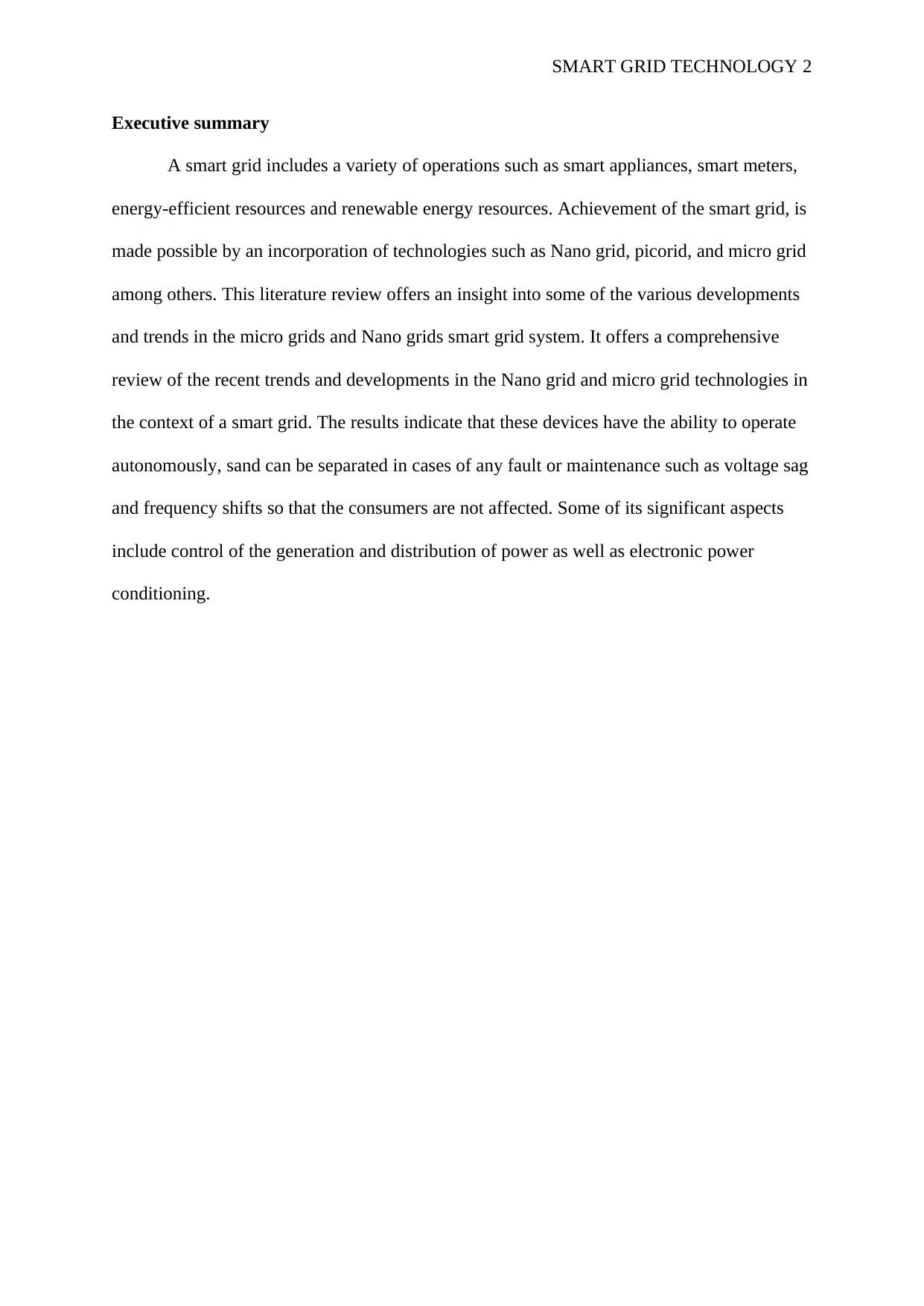
SMART GRID TECHNOLOGY 2
Executive summary
A smart grid includes a variety of operations such as smart appliances, smart meters,
energy-efficient resources and renewable energy resources. Achievement of the smart grid, is
made possible by an incorporation of technologies such as Nano grid, picorid, and micro grid
among others. This literature review offers an insight into some of the various developments
and trends in the micro grids and Nano grids smart grid system. It offers a comprehensive
review of the recent trends and developments in the Nano grid and micro grid technologies in
the context of a smart grid. The results indicate that these devices have the ability to operate
autonomously, sand can be separated in cases of any fault or maintenance such as voltage sag
and frequency shifts so that the consumers are not affected. Some of its significant aspects
include control of the generation and distribution of power as well as electronic power
conditioning.
Executive summary
A smart grid includes a variety of operations such as smart appliances, smart meters,
energy-efficient resources and renewable energy resources. Achievement of the smart grid, is
made possible by an incorporation of technologies such as Nano grid, picorid, and micro grid
among others. This literature review offers an insight into some of the various developments
and trends in the micro grids and Nano grids smart grid system. It offers a comprehensive
review of the recent trends and developments in the Nano grid and micro grid technologies in
the context of a smart grid. The results indicate that these devices have the ability to operate
autonomously, sand can be separated in cases of any fault or maintenance such as voltage sag
and frequency shifts so that the consumers are not affected. Some of its significant aspects
include control of the generation and distribution of power as well as electronic power
conditioning.
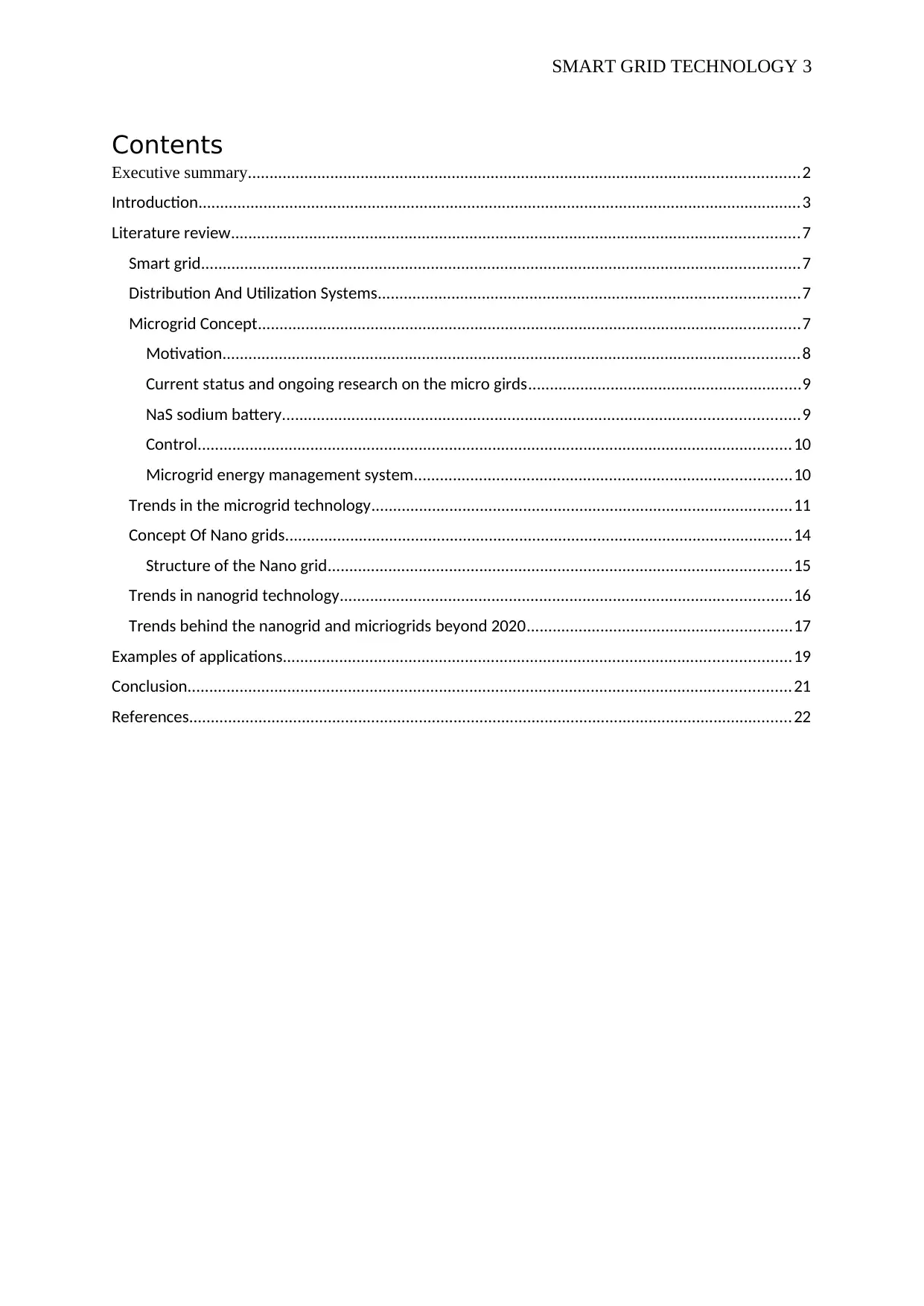
SMART GRID TECHNOLOGY 3
Contents
Executive summary...............................................................................................................................2
Introduction...........................................................................................................................................3
Literature review...................................................................................................................................7
Smart grid..........................................................................................................................................7
Distribution And Utilization Systems.................................................................................................7
Microgrid Concept.............................................................................................................................7
Motivation.....................................................................................................................................8
Current status and ongoing research on the micro girds...............................................................9
NaS sodium battery.......................................................................................................................9
Control.........................................................................................................................................10
Microgrid energy management system.......................................................................................10
Trends in the microgrid technology.................................................................................................11
Concept Of Nano grids.....................................................................................................................14
Structure of the Nano grid...........................................................................................................15
Trends in nanogrid technology........................................................................................................16
Trends behind the nanogrid and micriogrids beyond 2020.............................................................17
Examples of applications.....................................................................................................................19
Conclusion...........................................................................................................................................21
References...........................................................................................................................................22
Contents
Executive summary...............................................................................................................................2
Introduction...........................................................................................................................................3
Literature review...................................................................................................................................7
Smart grid..........................................................................................................................................7
Distribution And Utilization Systems.................................................................................................7
Microgrid Concept.............................................................................................................................7
Motivation.....................................................................................................................................8
Current status and ongoing research on the micro girds...............................................................9
NaS sodium battery.......................................................................................................................9
Control.........................................................................................................................................10
Microgrid energy management system.......................................................................................10
Trends in the microgrid technology.................................................................................................11
Concept Of Nano grids.....................................................................................................................14
Structure of the Nano grid...........................................................................................................15
Trends in nanogrid technology........................................................................................................16
Trends behind the nanogrid and micriogrids beyond 2020.............................................................17
Examples of applications.....................................................................................................................19
Conclusion...........................................................................................................................................21
References...........................................................................................................................................22
⊘ This is a preview!⊘
Do you want full access?
Subscribe today to unlock all pages.

Trusted by 1+ million students worldwide
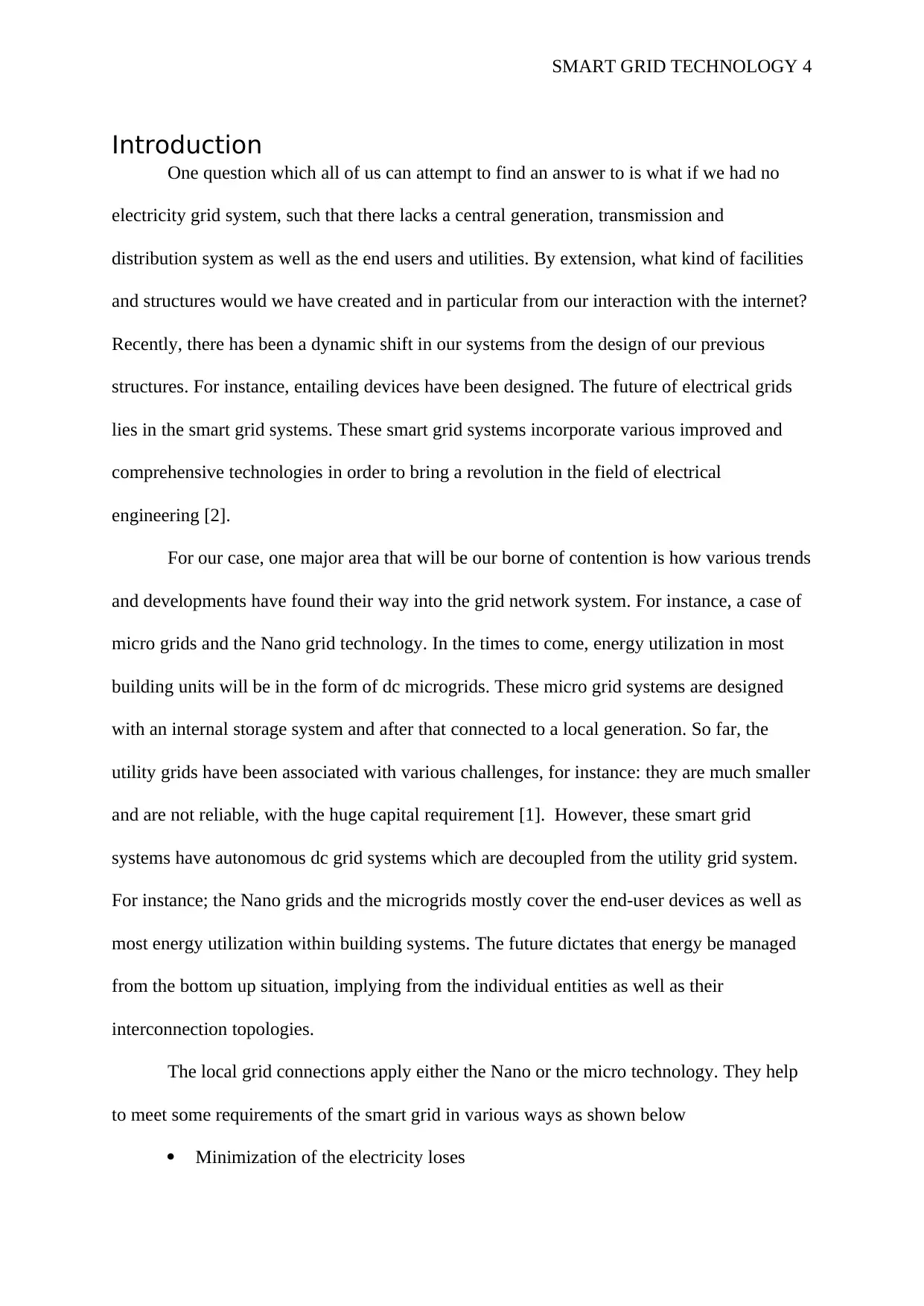
SMART GRID TECHNOLOGY 4
Introduction
One question which all of us can attempt to find an answer to is what if we had no
electricity grid system, such that there lacks a central generation, transmission and
distribution system as well as the end users and utilities. By extension, what kind of facilities
and structures would we have created and in particular from our interaction with the internet?
Recently, there has been a dynamic shift in our systems from the design of our previous
structures. For instance, entailing devices have been designed. The future of electrical grids
lies in the smart grid systems. These smart grid systems incorporate various improved and
comprehensive technologies in order to bring a revolution in the field of electrical
engineering [2].
For our case, one major area that will be our borne of contention is how various trends
and developments have found their way into the grid network system. For instance, a case of
micro grids and the Nano grid technology. In the times to come, energy utilization in most
building units will be in the form of dc microgrids. These micro grid systems are designed
with an internal storage system and after that connected to a local generation. So far, the
utility grids have been associated with various challenges, for instance: they are much smaller
and are not reliable, with the huge capital requirement [1]. However, these smart grid
systems have autonomous dc grid systems which are decoupled from the utility grid system.
For instance; the Nano grids and the microgrids mostly cover the end-user devices as well as
most energy utilization within building systems. The future dictates that energy be managed
from the bottom up situation, implying from the individual entities as well as their
interconnection topologies.
The local grid connections apply either the Nano or the micro technology. They help
to meet some requirements of the smart grid in various ways as shown below
Minimization of the electricity loses
Introduction
One question which all of us can attempt to find an answer to is what if we had no
electricity grid system, such that there lacks a central generation, transmission and
distribution system as well as the end users and utilities. By extension, what kind of facilities
and structures would we have created and in particular from our interaction with the internet?
Recently, there has been a dynamic shift in our systems from the design of our previous
structures. For instance, entailing devices have been designed. The future of electrical grids
lies in the smart grid systems. These smart grid systems incorporate various improved and
comprehensive technologies in order to bring a revolution in the field of electrical
engineering [2].
For our case, one major area that will be our borne of contention is how various trends
and developments have found their way into the grid network system. For instance, a case of
micro grids and the Nano grid technology. In the times to come, energy utilization in most
building units will be in the form of dc microgrids. These micro grid systems are designed
with an internal storage system and after that connected to a local generation. So far, the
utility grids have been associated with various challenges, for instance: they are much smaller
and are not reliable, with the huge capital requirement [1]. However, these smart grid
systems have autonomous dc grid systems which are decoupled from the utility grid system.
For instance; the Nano grids and the microgrids mostly cover the end-user devices as well as
most energy utilization within building systems. The future dictates that energy be managed
from the bottom up situation, implying from the individual entities as well as their
interconnection topologies.
The local grid connections apply either the Nano or the micro technology. They help
to meet some requirements of the smart grid in various ways as shown below
Minimization of the electricity loses
Paraphrase This Document
Need a fresh take? Get an instant paraphrase of this document with our AI Paraphraser
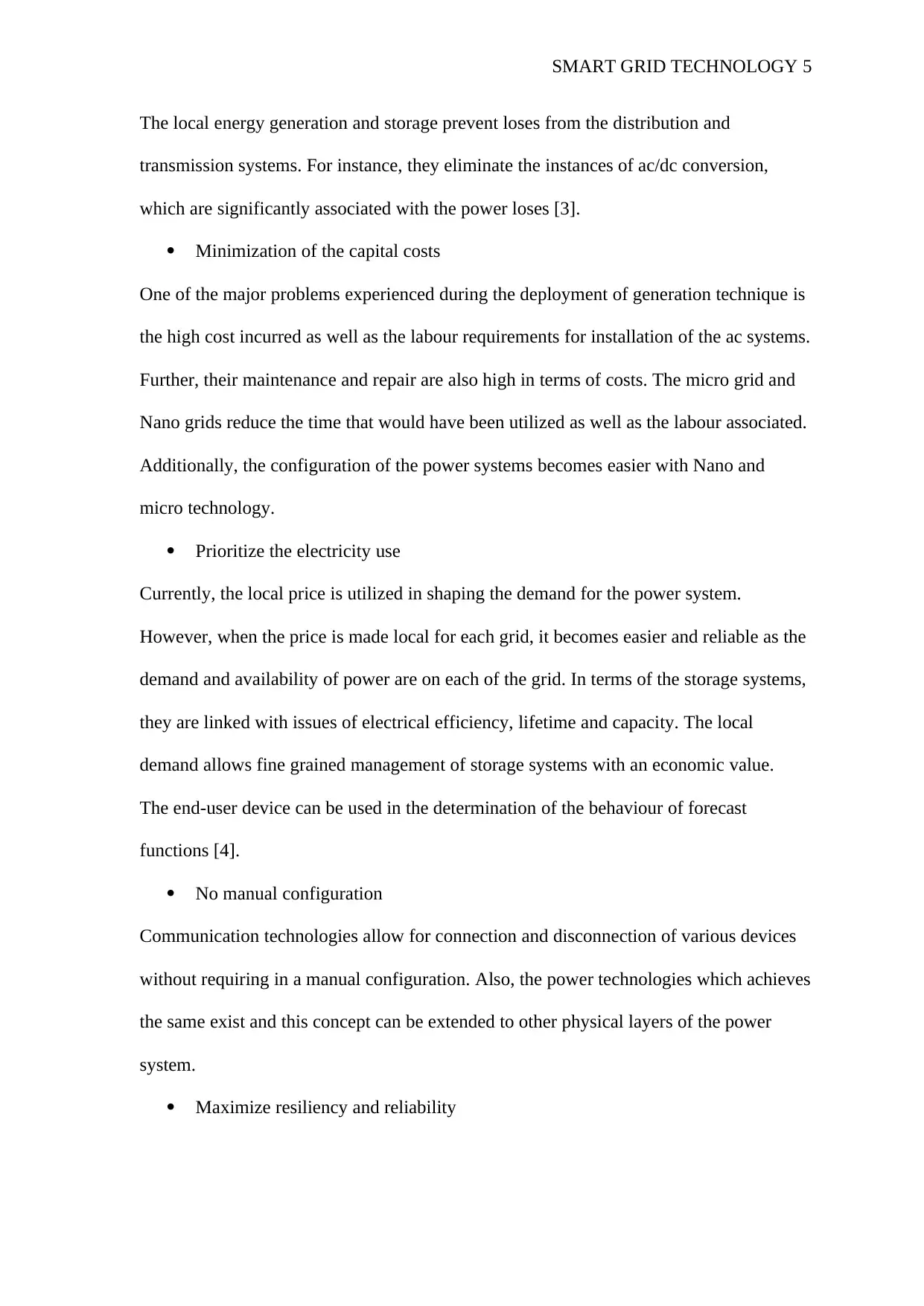
SMART GRID TECHNOLOGY 5
The local energy generation and storage prevent loses from the distribution and
transmission systems. For instance, they eliminate the instances of ac/dc conversion,
which are significantly associated with the power loses [3].
Minimization of the capital costs
One of the major problems experienced during the deployment of generation technique is
the high cost incurred as well as the labour requirements for installation of the ac systems.
Further, their maintenance and repair are also high in terms of costs. The micro grid and
Nano grids reduce the time that would have been utilized as well as the labour associated.
Additionally, the configuration of the power systems becomes easier with Nano and
micro technology.
Prioritize the electricity use
Currently, the local price is utilized in shaping the demand for the power system.
However, when the price is made local for each grid, it becomes easier and reliable as the
demand and availability of power are on each of the grid. In terms of the storage systems,
they are linked with issues of electrical efficiency, lifetime and capacity. The local
demand allows fine grained management of storage systems with an economic value.
The end-user device can be used in the determination of the behaviour of forecast
functions [4].
No manual configuration
Communication technologies allow for connection and disconnection of various devices
without requiring in a manual configuration. Also, the power technologies which achieves
the same exist and this concept can be extended to other physical layers of the power
system.
Maximize resiliency and reliability
The local energy generation and storage prevent loses from the distribution and
transmission systems. For instance, they eliminate the instances of ac/dc conversion,
which are significantly associated with the power loses [3].
Minimization of the capital costs
One of the major problems experienced during the deployment of generation technique is
the high cost incurred as well as the labour requirements for installation of the ac systems.
Further, their maintenance and repair are also high in terms of costs. The micro grid and
Nano grids reduce the time that would have been utilized as well as the labour associated.
Additionally, the configuration of the power systems becomes easier with Nano and
micro technology.
Prioritize the electricity use
Currently, the local price is utilized in shaping the demand for the power system.
However, when the price is made local for each grid, it becomes easier and reliable as the
demand and availability of power are on each of the grid. In terms of the storage systems,
they are linked with issues of electrical efficiency, lifetime and capacity. The local
demand allows fine grained management of storage systems with an economic value.
The end-user device can be used in the determination of the behaviour of forecast
functions [4].
No manual configuration
Communication technologies allow for connection and disconnection of various devices
without requiring in a manual configuration. Also, the power technologies which achieves
the same exist and this concept can be extended to other physical layers of the power
system.
Maximize resiliency and reliability

SMART GRID TECHNOLOGY 6
The local power distribution systems have the adaptability characterizes, making them
connect with any change in wiring or equipment's, including unexpected scenarios. It
optimally adapts in the best possible way, and it is not associated with any central entity
whose failure might affect other components. Through minimization of the complexity
and communication, the security risks that might be associated with the system are
reduced [5].
Easily interconnect electrical domains
The controllers in the nano grid and the micro grid easily coordinate with the
communications of the utility grid in order to give a balance to both the external and the
internal needs.
The local power distribution systems have the adaptability characterizes, making them
connect with any change in wiring or equipment's, including unexpected scenarios. It
optimally adapts in the best possible way, and it is not associated with any central entity
whose failure might affect other components. Through minimization of the complexity
and communication, the security risks that might be associated with the system are
reduced [5].
Easily interconnect electrical domains
The controllers in the nano grid and the micro grid easily coordinate with the
communications of the utility grid in order to give a balance to both the external and the
internal needs.
⊘ This is a preview!⊘
Do you want full access?
Subscribe today to unlock all pages.

Trusted by 1+ million students worldwide
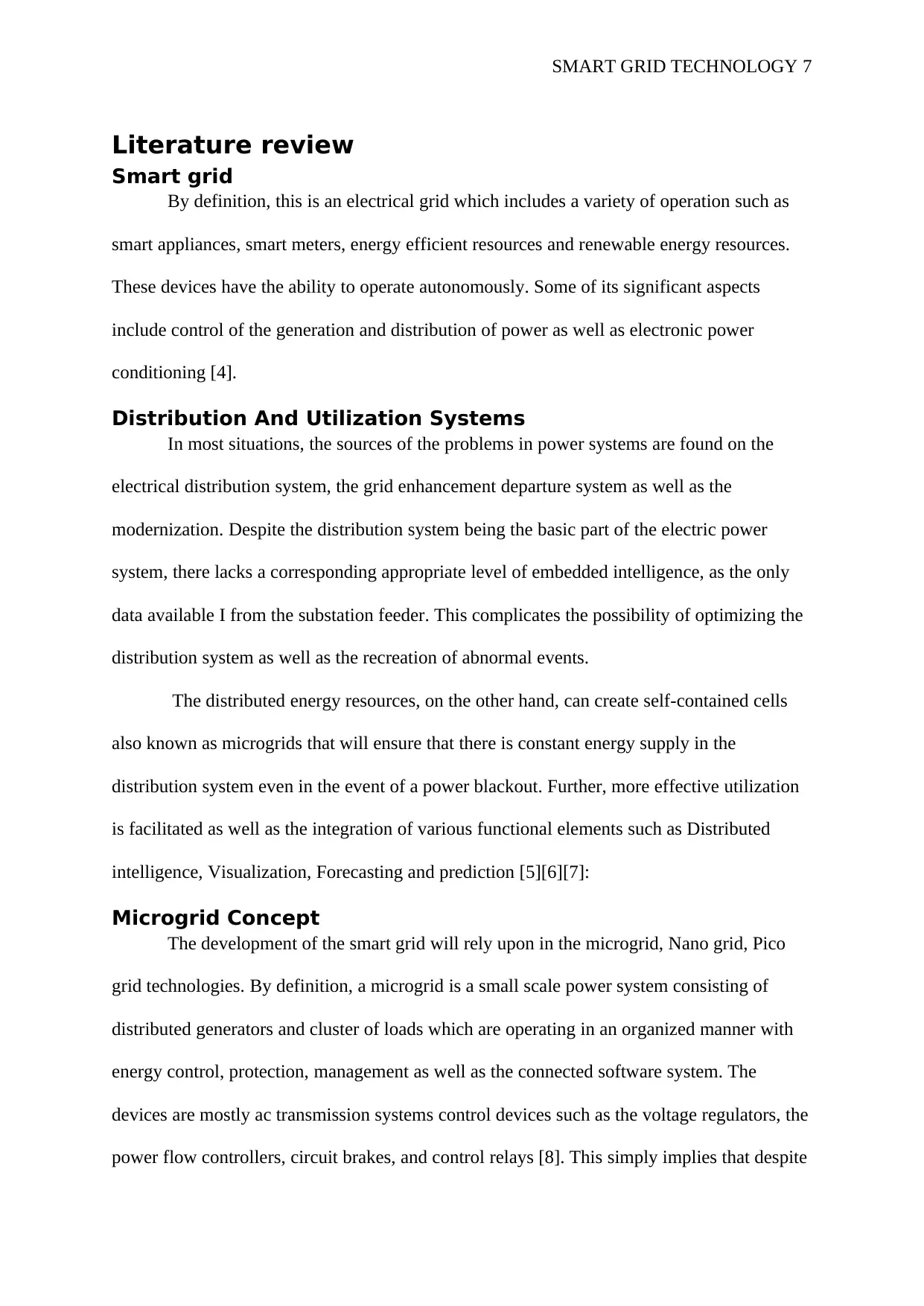
SMART GRID TECHNOLOGY 7
Literature review
Smart grid
By definition, this is an electrical grid which includes a variety of operation such as
smart appliances, smart meters, energy efficient resources and renewable energy resources.
These devices have the ability to operate autonomously. Some of its significant aspects
include control of the generation and distribution of power as well as electronic power
conditioning [4].
Distribution And Utilization Systems
In most situations, the sources of the problems in power systems are found on the
electrical distribution system, the grid enhancement departure system as well as the
modernization. Despite the distribution system being the basic part of the electric power
system, there lacks a corresponding appropriate level of embedded intelligence, as the only
data available I from the substation feeder. This complicates the possibility of optimizing the
distribution system as well as the recreation of abnormal events.
The distributed energy resources, on the other hand, can create self-contained cells
also known as microgrids that will ensure that there is constant energy supply in the
distribution system even in the event of a power blackout. Further, more effective utilization
is facilitated as well as the integration of various functional elements such as Distributed
intelligence, Visualization, Forecasting and prediction [5][6][7]:
Microgrid Concept
The development of the smart grid will rely upon in the microgrid, Nano grid, Pico
grid technologies. By definition, a microgrid is a small scale power system consisting of
distributed generators and cluster of loads which are operating in an organized manner with
energy control, protection, management as well as the connected software system. The
devices are mostly ac transmission systems control devices such as the voltage regulators, the
power flow controllers, circuit brakes, and control relays [8]. This simply implies that despite
Literature review
Smart grid
By definition, this is an electrical grid which includes a variety of operation such as
smart appliances, smart meters, energy efficient resources and renewable energy resources.
These devices have the ability to operate autonomously. Some of its significant aspects
include control of the generation and distribution of power as well as electronic power
conditioning [4].
Distribution And Utilization Systems
In most situations, the sources of the problems in power systems are found on the
electrical distribution system, the grid enhancement departure system as well as the
modernization. Despite the distribution system being the basic part of the electric power
system, there lacks a corresponding appropriate level of embedded intelligence, as the only
data available I from the substation feeder. This complicates the possibility of optimizing the
distribution system as well as the recreation of abnormal events.
The distributed energy resources, on the other hand, can create self-contained cells
also known as microgrids that will ensure that there is constant energy supply in the
distribution system even in the event of a power blackout. Further, more effective utilization
is facilitated as well as the integration of various functional elements such as Distributed
intelligence, Visualization, Forecasting and prediction [5][6][7]:
Microgrid Concept
The development of the smart grid will rely upon in the microgrid, Nano grid, Pico
grid technologies. By definition, a microgrid is a small scale power system consisting of
distributed generators and cluster of loads which are operating in an organized manner with
energy control, protection, management as well as the connected software system. The
devices are mostly ac transmission systems control devices such as the voltage regulators, the
power flow controllers, circuit brakes, and control relays [8]. This simply implies that despite
Paraphrase This Document
Need a fresh take? Get an instant paraphrase of this document with our AI Paraphraser
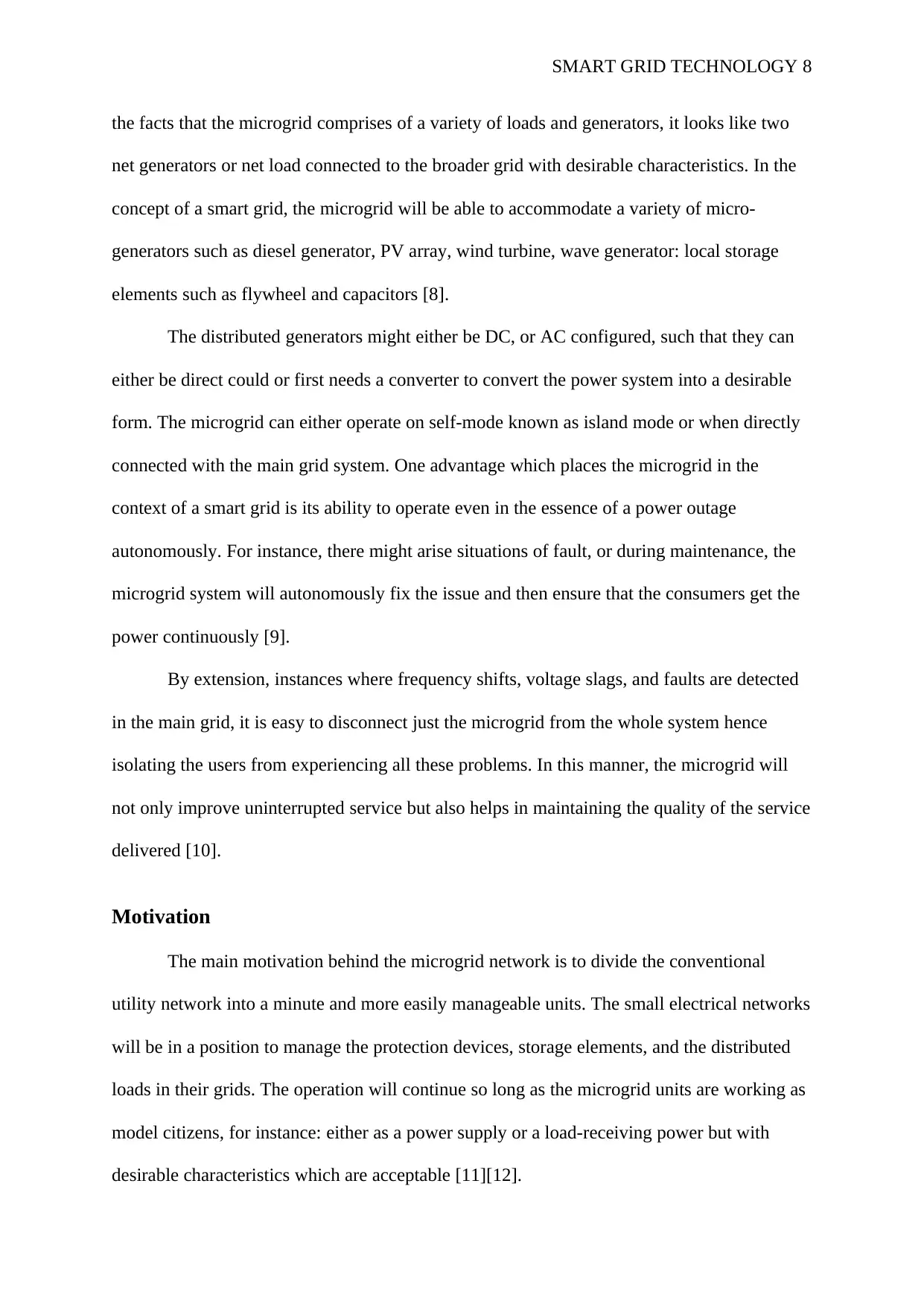
SMART GRID TECHNOLOGY 8
the facts that the microgrid comprises of a variety of loads and generators, it looks like two
net generators or net load connected to the broader grid with desirable characteristics. In the
concept of a smart grid, the microgrid will be able to accommodate a variety of micro-
generators such as diesel generator, PV array, wind turbine, wave generator: local storage
elements such as flywheel and capacitors [8].
The distributed generators might either be DC, or AC configured, such that they can
either be direct could or first needs a converter to convert the power system into a desirable
form. The microgrid can either operate on self-mode known as island mode or when directly
connected with the main grid system. One advantage which places the microgrid in the
context of a smart grid is its ability to operate even in the essence of a power outage
autonomously. For instance, there might arise situations of fault, or during maintenance, the
microgrid system will autonomously fix the issue and then ensure that the consumers get the
power continuously [9].
By extension, instances where frequency shifts, voltage slags, and faults are detected
in the main grid, it is easy to disconnect just the microgrid from the whole system hence
isolating the users from experiencing all these problems. In this manner, the microgrid will
not only improve uninterrupted service but also helps in maintaining the quality of the service
delivered [10].
Motivation
The main motivation behind the microgrid network is to divide the conventional
utility network into a minute and more easily manageable units. The small electrical networks
will be in a position to manage the protection devices, storage elements, and the distributed
loads in their grids. The operation will continue so long as the microgrid units are working as
model citizens, for instance: either as a power supply or a load-receiving power but with
desirable characteristics which are acceptable [11][12].
the facts that the microgrid comprises of a variety of loads and generators, it looks like two
net generators or net load connected to the broader grid with desirable characteristics. In the
concept of a smart grid, the microgrid will be able to accommodate a variety of micro-
generators such as diesel generator, PV array, wind turbine, wave generator: local storage
elements such as flywheel and capacitors [8].
The distributed generators might either be DC, or AC configured, such that they can
either be direct could or first needs a converter to convert the power system into a desirable
form. The microgrid can either operate on self-mode known as island mode or when directly
connected with the main grid system. One advantage which places the microgrid in the
context of a smart grid is its ability to operate even in the essence of a power outage
autonomously. For instance, there might arise situations of fault, or during maintenance, the
microgrid system will autonomously fix the issue and then ensure that the consumers get the
power continuously [9].
By extension, instances where frequency shifts, voltage slags, and faults are detected
in the main grid, it is easy to disconnect just the microgrid from the whole system hence
isolating the users from experiencing all these problems. In this manner, the microgrid will
not only improve uninterrupted service but also helps in maintaining the quality of the service
delivered [10].
Motivation
The main motivation behind the microgrid network is to divide the conventional
utility network into a minute and more easily manageable units. The small electrical networks
will be in a position to manage the protection devices, storage elements, and the distributed
loads in their grids. The operation will continue so long as the microgrid units are working as
model citizens, for instance: either as a power supply or a load-receiving power but with
desirable characteristics which are acceptable [11][12].
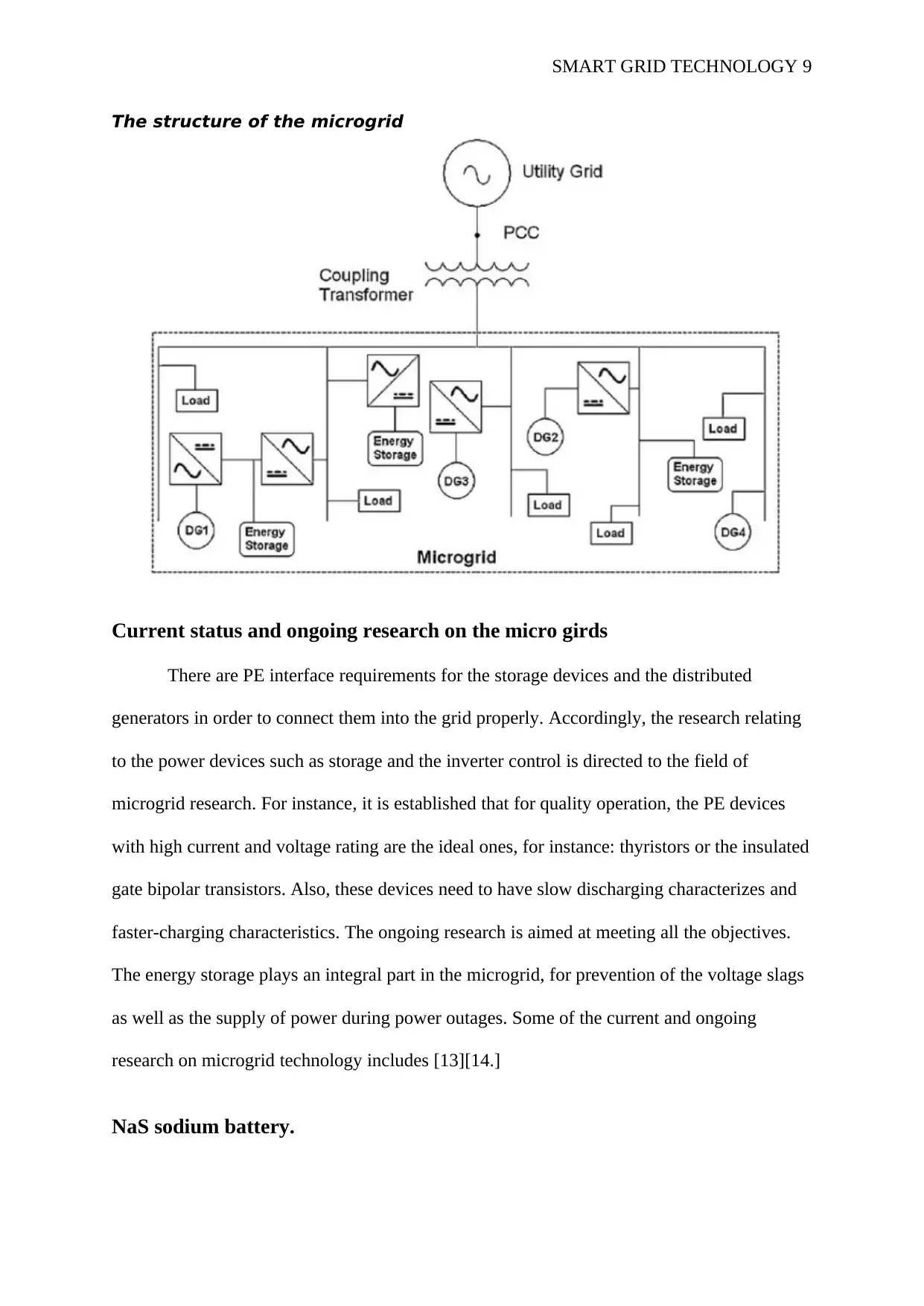
SMART GRID TECHNOLOGY 9
The structure of the microgrid
Current status and ongoing research on the micro girds
There are PE interface requirements for the storage devices and the distributed
generators in order to connect them into the grid properly. Accordingly, the research relating
to the power devices such as storage and the inverter control is directed to the field of
microgrid research. For instance, it is established that for quality operation, the PE devices
with high current and voltage rating are the ideal ones, for instance: thyristors or the insulated
gate bipolar transistors. Also, these devices need to have slow discharging characterizes and
faster-charging characteristics. The ongoing research is aimed at meeting all the objectives.
The energy storage plays an integral part in the microgrid, for prevention of the voltage slags
as well as the supply of power during power outages. Some of the current and ongoing
research on microgrid technology includes [13][14.]
NaS sodium battery.
The structure of the microgrid
Current status and ongoing research on the micro girds
There are PE interface requirements for the storage devices and the distributed
generators in order to connect them into the grid properly. Accordingly, the research relating
to the power devices such as storage and the inverter control is directed to the field of
microgrid research. For instance, it is established that for quality operation, the PE devices
with high current and voltage rating are the ideal ones, for instance: thyristors or the insulated
gate bipolar transistors. Also, these devices need to have slow discharging characterizes and
faster-charging characteristics. The ongoing research is aimed at meeting all the objectives.
The energy storage plays an integral part in the microgrid, for prevention of the voltage slags
as well as the supply of power during power outages. Some of the current and ongoing
research on microgrid technology includes [13][14.]
NaS sodium battery.
⊘ This is a preview!⊘
Do you want full access?
Subscribe today to unlock all pages.

Trusted by 1+ million students worldwide
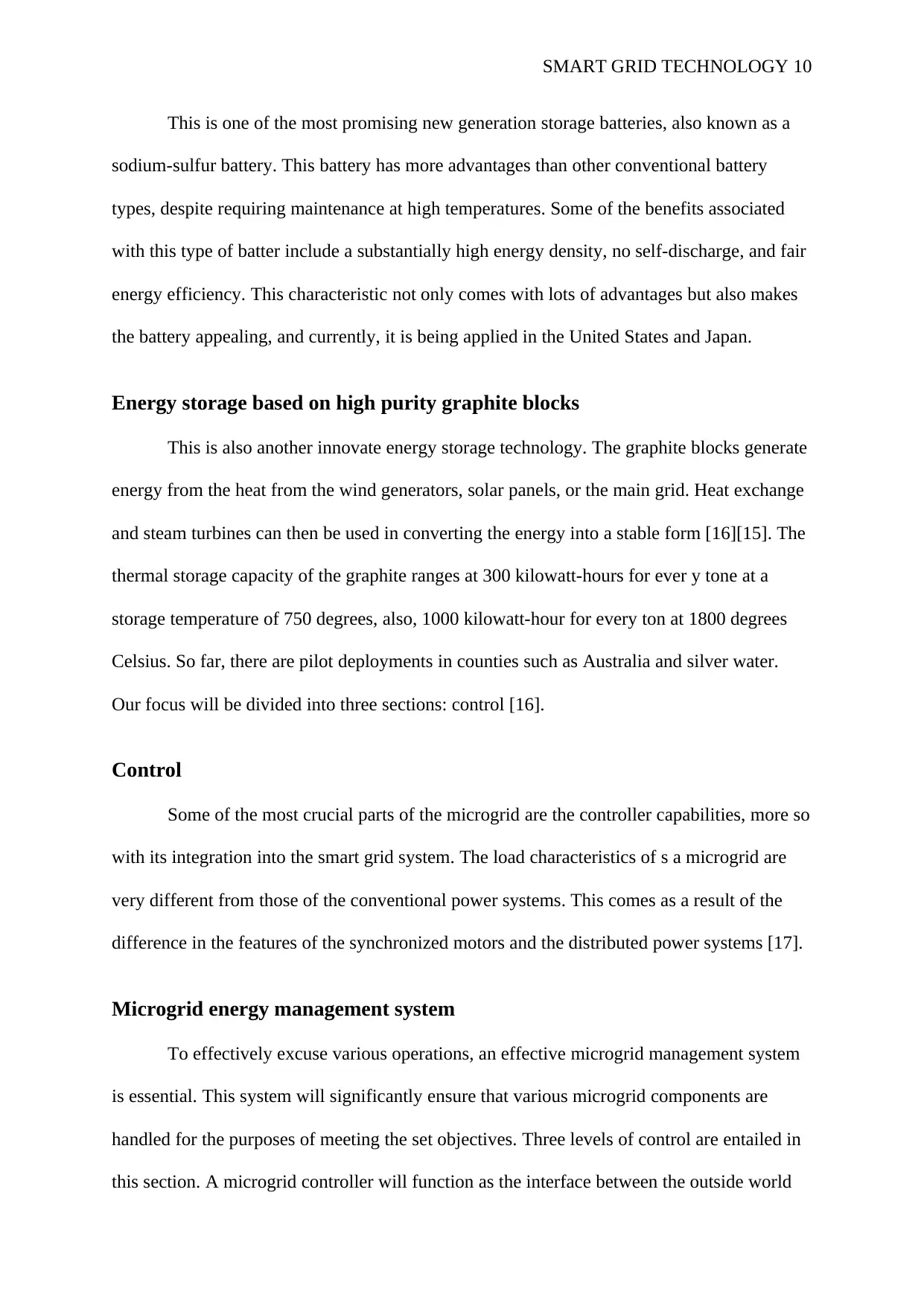
SMART GRID TECHNOLOGY 10
This is one of the most promising new generation storage batteries, also known as a
sodium-sulfur battery. This battery has more advantages than other conventional battery
types, despite requiring maintenance at high temperatures. Some of the benefits associated
with this type of batter include a substantially high energy density, no self-discharge, and fair
energy efficiency. This characteristic not only comes with lots of advantages but also makes
the battery appealing, and currently, it is being applied in the United States and Japan.
Energy storage based on high purity graphite blocks
This is also another innovate energy storage technology. The graphite blocks generate
energy from the heat from the wind generators, solar panels, or the main grid. Heat exchange
and steam turbines can then be used in converting the energy into a stable form [16][15]. The
thermal storage capacity of the graphite ranges at 300 kilowatt-hours for ever y tone at a
storage temperature of 750 degrees, also, 1000 kilowatt-hour for every ton at 1800 degrees
Celsius. So far, there are pilot deployments in counties such as Australia and silver water.
Our focus will be divided into three sections: control [16].
Control
Some of the most crucial parts of the microgrid are the controller capabilities, more so
with its integration into the smart grid system. The load characteristics of s a microgrid are
very different from those of the conventional power systems. This comes as a result of the
difference in the features of the synchronized motors and the distributed power systems [17].
Microgrid energy management system
To effectively excuse various operations, an effective microgrid management system
is essential. This system will significantly ensure that various microgrid components are
handled for the purposes of meeting the set objectives. Three levels of control are entailed in
this section. A microgrid controller will function as the interface between the outside world
This is one of the most promising new generation storage batteries, also known as a
sodium-sulfur battery. This battery has more advantages than other conventional battery
types, despite requiring maintenance at high temperatures. Some of the benefits associated
with this type of batter include a substantially high energy density, no self-discharge, and fair
energy efficiency. This characteristic not only comes with lots of advantages but also makes
the battery appealing, and currently, it is being applied in the United States and Japan.
Energy storage based on high purity graphite blocks
This is also another innovate energy storage technology. The graphite blocks generate
energy from the heat from the wind generators, solar panels, or the main grid. Heat exchange
and steam turbines can then be used in converting the energy into a stable form [16][15]. The
thermal storage capacity of the graphite ranges at 300 kilowatt-hours for ever y tone at a
storage temperature of 750 degrees, also, 1000 kilowatt-hour for every ton at 1800 degrees
Celsius. So far, there are pilot deployments in counties such as Australia and silver water.
Our focus will be divided into three sections: control [16].
Control
Some of the most crucial parts of the microgrid are the controller capabilities, more so
with its integration into the smart grid system. The load characteristics of s a microgrid are
very different from those of the conventional power systems. This comes as a result of the
difference in the features of the synchronized motors and the distributed power systems [17].
Microgrid energy management system
To effectively excuse various operations, an effective microgrid management system
is essential. This system will significantly ensure that various microgrid components are
handled for the purposes of meeting the set objectives. Three levels of control are entailed in
this section. A microgrid controller will function as the interface between the outside world
Paraphrase This Document
Need a fresh take? Get an instant paraphrase of this document with our AI Paraphraser
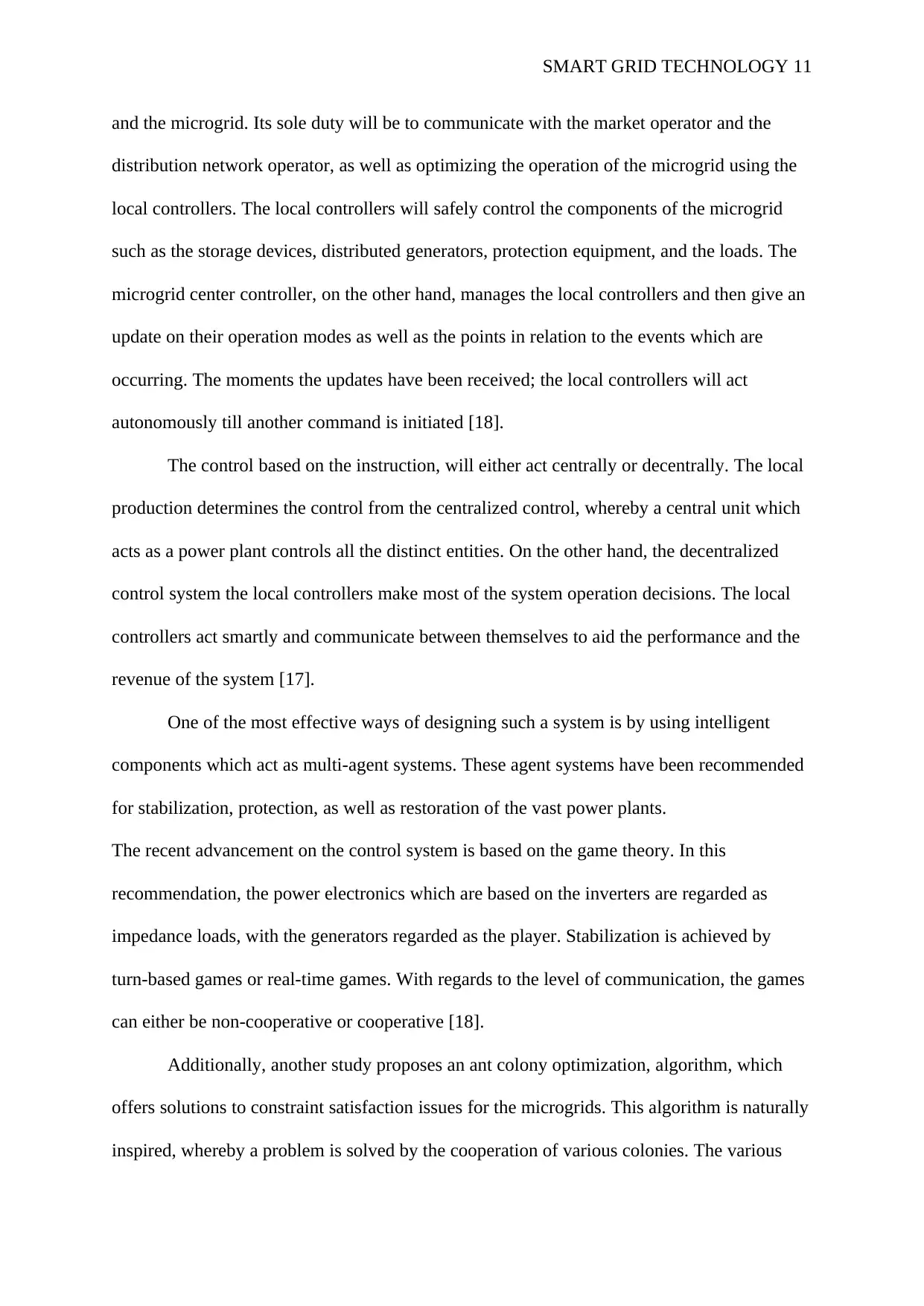
SMART GRID TECHNOLOGY 11
and the microgrid. Its sole duty will be to communicate with the market operator and the
distribution network operator, as well as optimizing the operation of the microgrid using the
local controllers. The local controllers will safely control the components of the microgrid
such as the storage devices, distributed generators, protection equipment, and the loads. The
microgrid center controller, on the other hand, manages the local controllers and then give an
update on their operation modes as well as the points in relation to the events which are
occurring. The moments the updates have been received; the local controllers will act
autonomously till another command is initiated [18].
The control based on the instruction, will either act centrally or decentrally. The local
production determines the control from the centralized control, whereby a central unit which
acts as a power plant controls all the distinct entities. On the other hand, the decentralized
control system the local controllers make most of the system operation decisions. The local
controllers act smartly and communicate between themselves to aid the performance and the
revenue of the system [17].
One of the most effective ways of designing such a system is by using intelligent
components which act as multi-agent systems. These agent systems have been recommended
for stabilization, protection, as well as restoration of the vast power plants.
The recent advancement on the control system is based on the game theory. In this
recommendation, the power electronics which are based on the inverters are regarded as
impedance loads, with the generators regarded as the player. Stabilization is achieved by
turn-based games or real-time games. With regards to the level of communication, the games
can either be non-cooperative or cooperative [18].
Additionally, another study proposes an ant colony optimization, algorithm, which
offers solutions to constraint satisfaction issues for the microgrids. This algorithm is naturally
inspired, whereby a problem is solved by the cooperation of various colonies. The various
and the microgrid. Its sole duty will be to communicate with the market operator and the
distribution network operator, as well as optimizing the operation of the microgrid using the
local controllers. The local controllers will safely control the components of the microgrid
such as the storage devices, distributed generators, protection equipment, and the loads. The
microgrid center controller, on the other hand, manages the local controllers and then give an
update on their operation modes as well as the points in relation to the events which are
occurring. The moments the updates have been received; the local controllers will act
autonomously till another command is initiated [18].
The control based on the instruction, will either act centrally or decentrally. The local
production determines the control from the centralized control, whereby a central unit which
acts as a power plant controls all the distinct entities. On the other hand, the decentralized
control system the local controllers make most of the system operation decisions. The local
controllers act smartly and communicate between themselves to aid the performance and the
revenue of the system [17].
One of the most effective ways of designing such a system is by using intelligent
components which act as multi-agent systems. These agent systems have been recommended
for stabilization, protection, as well as restoration of the vast power plants.
The recent advancement on the control system is based on the game theory. In this
recommendation, the power electronics which are based on the inverters are regarded as
impedance loads, with the generators regarded as the player. Stabilization is achieved by
turn-based games or real-time games. With regards to the level of communication, the games
can either be non-cooperative or cooperative [18].
Additionally, another study proposes an ant colony optimization, algorithm, which
offers solutions to constraint satisfaction issues for the microgrids. This algorithm is naturally
inspired, whereby a problem is solved by the cooperation of various colonies. The various
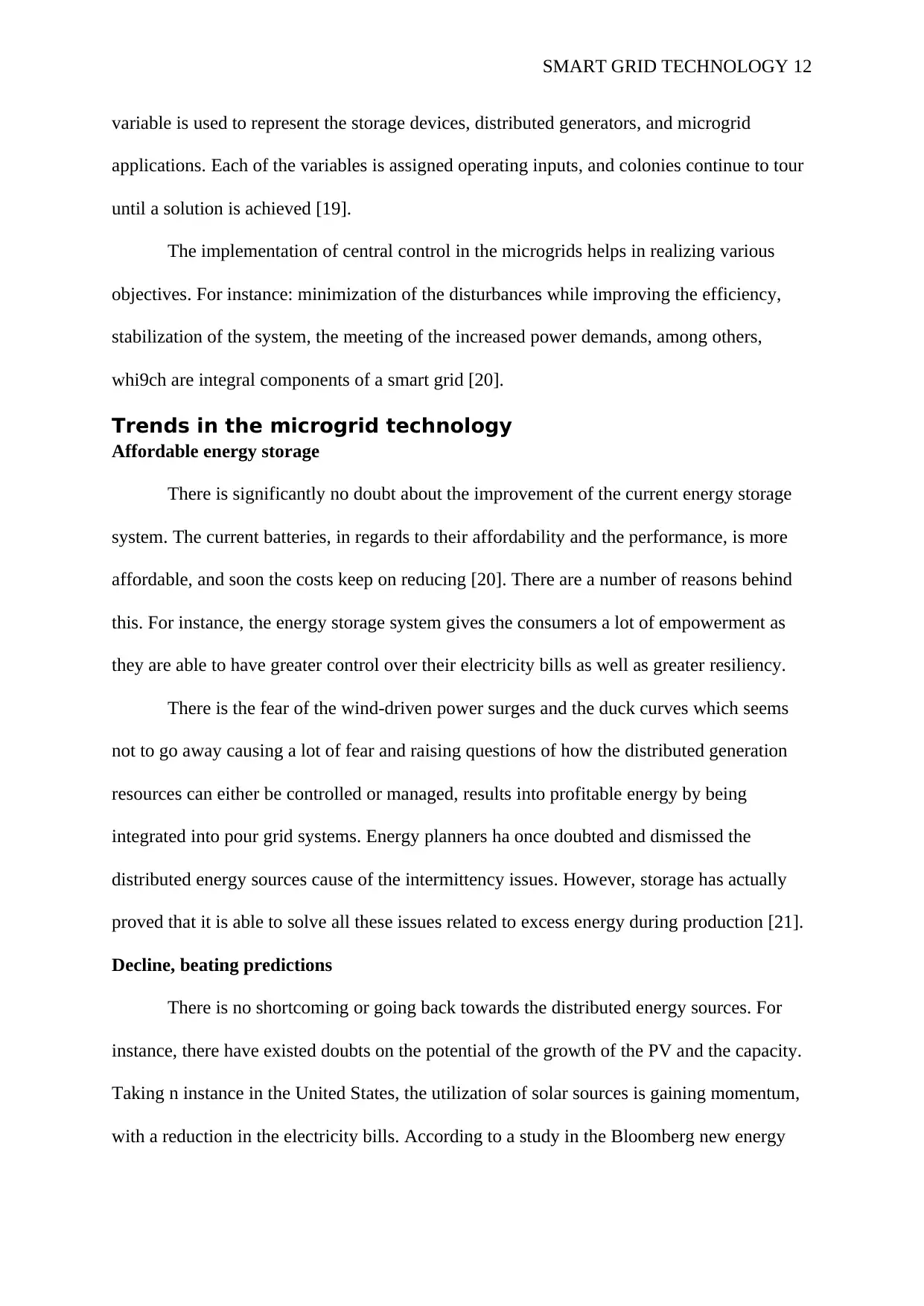
SMART GRID TECHNOLOGY 12
variable is used to represent the storage devices, distributed generators, and microgrid
applications. Each of the variables is assigned operating inputs, and colonies continue to tour
until a solution is achieved [19].
The implementation of central control in the microgrids helps in realizing various
objectives. For instance: minimization of the disturbances while improving the efficiency,
stabilization of the system, the meeting of the increased power demands, among others,
whi9ch are integral components of a smart grid [20].
Trends in the microgrid technology
Affordable energy storage
There is significantly no doubt about the improvement of the current energy storage
system. The current batteries, in regards to their affordability and the performance, is more
affordable, and soon the costs keep on reducing [20]. There are a number of reasons behind
this. For instance, the energy storage system gives the consumers a lot of empowerment as
they are able to have greater control over their electricity bills as well as greater resiliency.
There is the fear of the wind-driven power surges and the duck curves which seems
not to go away causing a lot of fear and raising questions of how the distributed generation
resources can either be controlled or managed, results into profitable energy by being
integrated into pour grid systems. Energy planners ha once doubted and dismissed the
distributed energy sources cause of the intermittency issues. However, storage has actually
proved that it is able to solve all these issues related to excess energy during production [21].
Decline, beating predictions
There is no shortcoming or going back towards the distributed energy sources. For
instance, there have existed doubts on the potential of the growth of the PV and the capacity.
Taking n instance in the United States, the utilization of solar sources is gaining momentum,
with a reduction in the electricity bills. According to a study in the Bloomberg new energy
variable is used to represent the storage devices, distributed generators, and microgrid
applications. Each of the variables is assigned operating inputs, and colonies continue to tour
until a solution is achieved [19].
The implementation of central control in the microgrids helps in realizing various
objectives. For instance: minimization of the disturbances while improving the efficiency,
stabilization of the system, the meeting of the increased power demands, among others,
whi9ch are integral components of a smart grid [20].
Trends in the microgrid technology
Affordable energy storage
There is significantly no doubt about the improvement of the current energy storage
system. The current batteries, in regards to their affordability and the performance, is more
affordable, and soon the costs keep on reducing [20]. There are a number of reasons behind
this. For instance, the energy storage system gives the consumers a lot of empowerment as
they are able to have greater control over their electricity bills as well as greater resiliency.
There is the fear of the wind-driven power surges and the duck curves which seems
not to go away causing a lot of fear and raising questions of how the distributed generation
resources can either be controlled or managed, results into profitable energy by being
integrated into pour grid systems. Energy planners ha once doubted and dismissed the
distributed energy sources cause of the intermittency issues. However, storage has actually
proved that it is able to solve all these issues related to excess energy during production [21].
Decline, beating predictions
There is no shortcoming or going back towards the distributed energy sources. For
instance, there have existed doubts on the potential of the growth of the PV and the capacity.
Taking n instance in the United States, the utilization of solar sources is gaining momentum,
with a reduction in the electricity bills. According to a study in the Bloomberg new energy
⊘ This is a preview!⊘
Do you want full access?
Subscribe today to unlock all pages.

Trusted by 1+ million students worldwide
1 out of 26
Related Documents
Your All-in-One AI-Powered Toolkit for Academic Success.
+13062052269
info@desklib.com
Available 24*7 on WhatsApp / Email
![[object Object]](/_next/static/media/star-bottom.7253800d.svg)
Unlock your academic potential
Copyright © 2020–2025 A2Z Services. All Rights Reserved. Developed and managed by ZUCOL.





